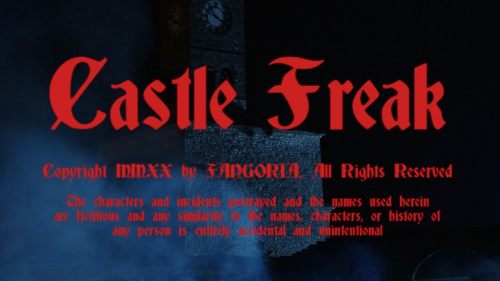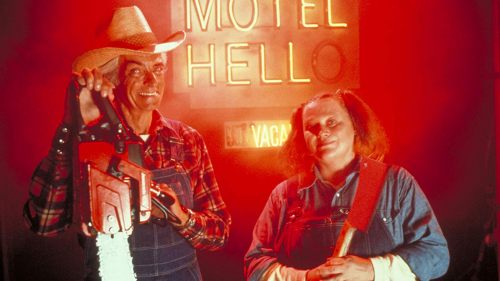Cinepocalypse 2019: SATANIC PANIC Only Induces Mild Consternation
Horror seems unique amongst film genres in that writers and directors seem to have a need for the audience to know just how much they love horror movies - often at the expense of genuine storytelling. Packed with references to the movies they grew up on, their films are more like exercises in retrospective hagiography than stories in their own right. This particular flavour of exuberance comes from a good-hearted place, but the films themselves feel juvenile and shallow, all about genre trappings above characters or stories.
Produced by Fangoria’s fledgling production imprint, Satanic Panic isn’t the most egregious of these movies, but it is definitely one of them. Characters and streets aren’t named after horror directors from the ‘70s and ‘80s. The titles aren’t set in John Carpenter's favourite font Albertus. But characters reference horror in dialogue with greater frequency than most people would - one character describes a prop as “H.R. Giger,” which isn’t even an accurate description of the prop in question - and more importantly, the characters themselves appear to be in on the joke, aware that they’re in a horror comedy without ever stating it. Story beats happen in Satanic Panic because they’re things that happen in horror movies, with little genuine motivation to drive them.
Satanic Panic centres on Sam (Hayley Griffith), a fledgling pizza delivery girl desperate for the tips that make the job actually profitable. Delivering a stack of pizzas to a snooty, wealthy neighbourhood, Sam gets stiffed for a tip off a $100 purchase. Venturing inside to request a tip, she discovers a coven of well-to-do Satanic suburbanites who would be summoning Baphomet that night, save for the fact they’ve lost their sacrificial virgin. Given that Sam is, herself, a virgin, things take quite a turn.
That’s a decent setup! It’s a nice inversion of the “Satanic Panic” that once dominated suburban life, and the intersection of class power and Satanic power has a lot of potential. But director Chelsea Stardust doesn’t seem interested in exploring these ideas - anyone hoping for a deconstruction of cultural Satanic Panic will be quite disappointed - as much as she’s interested in making a broad-spectrum homage to the movies she loves. Her enthusiasm is right there on the film’s sleeve, but it isn’t matched in execution. The film is lit and shot as a comedy, not horror, robbing it of atmosphere and dramatic weight, and making what would otherwise read as dry humour play like broad, wacky comedy.
If there’s one element that sinks Satanic Panic, it’s the performances. Broad, winking, and shrill, the film has the air of a community theatre performance. Griffith acquits herself well, navigating with gusto a character who’s mostly reactive, while Jerry O’Connell and the ever-reliable AJ Bowen deliver entertaining extended cameos. The rest of the cast, though, overacts to irritating extremes, sucking out any subtlety and turning each character - and the movie, in turn - into a caricature. Even Rebecca Romijn overplays the dark comedy in her coven-leader role. With jokes this telegraphed, it’s hard to do much more than groan. Maybe that's the intention; it's unclear.
In spite of all this, Satanic Panic does deliver a number of solid setpieces and gore gags, and a handful of truly laugh-out-loud jokes (the best of which lands before Satanism is even introduced). Only O’Connell truly finds a performance style to match the film’s intentions, but his single scene is a riot as a result. Some of the gore is pretty funny, as when a character undergoes what the filmmakers definitely referred to on set as “a City of the Living Dead” for a spell of clairvoyance. But whatever individual identity the film has is frequently subsumed in homage - most egregiously, in an object-possession sequence straight out of The Evil Dead in concept, but not even close in execution.
What all of this adds up to is a self-satisfied movie clearly made for audiences who think the mere mention of Satan is both extremely awesome and extremely hilarious. (It isn’t - at least, not by itself.) There’s blood, but no horror; jokes, but little comedy. Characters ignore what’s going on in order to deliver one-liners so signposted they might as well be festooned with blinking LEDs. The movie doesn’t even provide a decent climax for its protagonist, instead conjuring a literal deus ex machina to solve her predicament, before cutting to an unearned and barely even set-up resolution.
Satanic Panic is bursting with energy and ambition, which might well be its Achilles’ heel. There clearly just wasn’t enough money in the budget to realise the film in its best possible form; accordingly, it’s mostly passable, sometimes getting its head above water, at other times descending into amateurishness. Though there’s a story buried in there, it’s not told to its maximum potential, instead buried under derivative horror setpieces and incongruous jokes.
As patronising as it sounds, many Fangoria-reading audience members will get something out of this film. If you’re looking for is a movie with some inventive effects, Satanic-themed laughs, and a bouncy, fun spirit, Satanic Panic will satisfy. But if you're looking for something original, deliver your pizzas to a different house.



